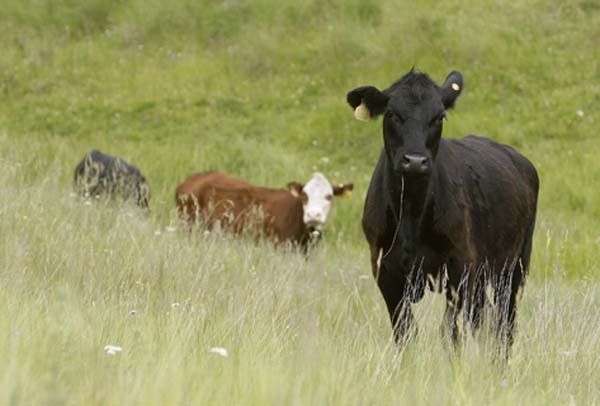ALBUQUERQUE, N.M. — More than 100 young Angus and Hereford bulls are on a working vacation at 8,700 feet above sea level in northern New Mexico, chomping on lush, high-meadow grass, helping researchers and ranchers get a handle on a disease that causes 75,000 cattle deaths each year across the West.
In a study by New Mexico State University and the New Mexico Beef Cattle Performance Association, researchers are conducting high-altitude cattle performance testing on the bulls to determine which are susceptible to high altitude disease. The findings could help ranchers develop a genetic line of altitude-resistant cattle.
An estimated 1.5 million cattle are raised annually at high elevations in Colorado, Wyoming,Utah and New Mexico. High-altitude disease - essentially a bovine equivalent to human hypertension - strikes herds that graze above 5,000 feet.
The disease kills 3 percent to 5 percent of the cattle each year, a loss valued at more than $60 million, said Tim Holt, veterinarian and professor at Colorado State University.
Manny Encinias, beef specialist at New Mexico State, said the project is the first time cattle have been tested in a centralized high altitude performance program on a grass-only diet.
"It has two unique aspects. Most performance tests use grain to achieve performance, and we do it at 8,700 feet and on 100 percent grass," Encinias said.
Ranchers placed cattle on the Valles Caldera National Preserve on June 1. The daily monitoring runs through the preserve's allotted 120-day grazing season.
The research team uses a pulmonary arterial pressure test, known as a PAP, affixing a flexible catheter to detect high pressure in the pulmonary artery near the heart. The researchers are also monitoring weight gain.
High-elevation ranchers say the research is essential.
"For the person buying the cattle, they can't afford to go up there and have the bulls die on them," said Bob Anderson, who with his wife, Kay, raises Angus bulls in Villanueva, N.M., at 6,000 feet.
"It's a way to help ranchers save money and it's another sales tool we have available," he said.
The illness is caused by lack of oxygen, leading to high pulmonary arterial pressures. Symptoms include lethargy and accumulation of fluid in the chest, or brisket area, of the cow. The disease can occur in all cattle breeds, male and female. Left untreated, it can cause congestive heart failure, leading to death.
"It's a stressor," Encinias said. "If you buy something with good genetics and you don't know how vulnerable they are to the disease, you could lose a bull because he could just go into acute heart failure."
Efforts to create altitude-resistant herds have paid off for the Tybar Ranch in Carbondale, Colo. Manager Mark Nieslanik said every cow on the ranch has been PAP tested since 1984.
"We've created a niche market, and we just happened to be progressive enough to stay ahead of the game because the Angus market is pretty competitive," Nieslanik said. "The economic losses of making a breeding mistake are pretty substantial."
Animals susceptible to high altitude disease are highly likely to pass the trait to offspring, Encinias said.
Veterinarian Holt performed PAP testing of the bulls in July. A nationally recognized authority on high-altitude disease and PAP testing, he has tested more than 190,000 cattle in the Rocky Mountain region.
The Valles Caldera cattle tested well and a few with high PAP results were sent back totheir ranches at lower elevations, Holt said. Animals showing early symptoms tend to improve if they are moved to lower elevations.
"What you do is use those for lowland breeding and not send their offspring to high elevations," Holt said.
Researchers plan to sell the top 35 percent of high-performing cattle to commercial ranchers, with proceeds going to the cow's owner.
Holt said he is excited by New Mexico State's grass-based study and curious to see which genetics show a trend for disease resistance.
"The data we will learn from this study is tremendous," Holt said.
Business, Pages 21, 26 on 08/25/2009
